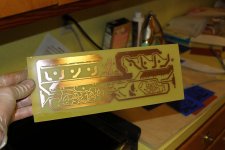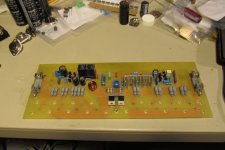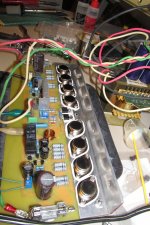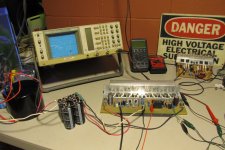I just completed my second amplifier Nbip300 by Quasi using the BLUE toner transfer method then drilling the holes with my dremel, it turned out great.
http://sites.google.com/site/quasisdiyaudiosite/nbip-series/nbip300
The amp works perfect, its dead silent at rest and has a really great PCB layout using TO3 transistors… I love it… BUT I am having a gain problem and can only produce 109 watts of unclipped power into 8 ohms.
I am using MJ15024G transistors everything else is exactly the same as the schematic.
My power source is from a vintage Pioneer receiver SX-3900 rated at 125 watts per channel so theoretically I should be able to achieve 250 watts into one 8 ohm speaker. Output voltage is 47.5 - 0 - 47.5 with 48,000uF storage caps
I tested with a 1.2v RMS sine at 1Khz into an 8.3 ohm resistor bank. Output of the amplifier was 30volts RMS and showed no clipping on my scope. Peek to Peek voltage was 83.2 volts.
My power rails started at 64 volts then dropped to 59.6v under full loading.
I need more gain, I would like to achieve 175 to 200 watts at 8 ohms in this module.
My assumption is that the Hfe is too low in the MJ15024 transistors? Although it’s the exact same as the 2N3773 transistor (Hfe = 15 min)
Can I reduce the feedback resistor to solve this?
What is max input voltage for a stage like this if I use a preamplifier?
Thanks for your input, again I really like this amp although I may have to beef up the protection a bit.
Pat
http://sites.google.com/site/quasisdiyaudiosite/nbip-series/nbip300
The amp works perfect, its dead silent at rest and has a really great PCB layout using TO3 transistors… I love it… BUT I am having a gain problem and can only produce 109 watts of unclipped power into 8 ohms.
I am using MJ15024G transistors everything else is exactly the same as the schematic.
My power source is from a vintage Pioneer receiver SX-3900 rated at 125 watts per channel so theoretically I should be able to achieve 250 watts into one 8 ohm speaker. Output voltage is 47.5 - 0 - 47.5 with 48,000uF storage caps
I tested with a 1.2v RMS sine at 1Khz into an 8.3 ohm resistor bank. Output of the amplifier was 30volts RMS and showed no clipping on my scope. Peek to Peek voltage was 83.2 volts.
My power rails started at 64 volts then dropped to 59.6v under full loading.
I need more gain, I would like to achieve 175 to 200 watts at 8 ohms in this module.
My assumption is that the Hfe is too low in the MJ15024 transistors? Although it’s the exact same as the 2N3773 transistor (Hfe = 15 min)
Can I reduce the feedback resistor to solve this?
What is max input voltage for a stage like this if I use a preamplifier?
Thanks for your input, again I really like this amp although I may have to beef up the protection a bit.
Pat
Attachments
I did notice something odd. I measured the output on my scope at 30v RMS and 83v peek...? this does not add up. 83v x 0.707 = 58 volts RMS
I did a double check and just ran the amp again and measured with my scope and meter... both said 30v RMS and again the scope said 83 volts peek to peek.
I am certain of only 100 watt output due to the decibels produced by my PA speaker so I'm not sure why the scope measures 83 peek... we can work off the RMS reading for now...
I did a double check and just ran the amp again and measured with my scope and meter... both said 30v RMS and again the scope said 83 volts peek to peek.
I am certain of only 100 watt output due to the decibels produced by my PA speaker so I'm not sure why the scope measures 83 peek... we can work off the RMS reading for now...
R18 !!!!!!!!!!
I,ve been looking all week and sure enough as soon as I post THEN I find the solution...
I jumped another resistor across R18 and I have lots of gain now
I was going to change R19
This thing CRANKS... My 13 year old daughter is yelling at me...Too loud she says...
I'm so excited this thing is great..
I,ve been looking all week and sure enough as soon as I post THEN I find the solution...
I jumped another resistor across R18 and I have lots of gain now
I was going to change R19
This thing CRANKS... My 13 year old daughter is yelling at me...Too loud she says...
I'm so excited this thing is great..
I just measured again with the gain increase and got 37 volts before clipping and something like 47 volts RMS max but then my sine looked like a square wave at this point...
REALLY my transformer is not large enough?
I'm thinking the VA has to be about right but your going to tell me my voltage is not high enough right?
REALLY my transformer is not large enough?
I'm thinking the VA has to be about right but your going to tell me my voltage is not high enough right?
This is all great info… Thanks… I currently have enough knowledge to be dangerous and stupidJ
Here is what I read about this Nbip amplifier... (I hope I didn’t screw up)
"This amplifier "Brother of Quasi" must not be connected to rails over +/- 70v DC at idle. This means that the transformer selected must not be more than 50v 0 50v with no load connected.
I.e; 50v - 0.6v (rectifier) * 1.414 = 69.9 volts.
Under full power this will drop by about 10% to 63 volts and the amp will drop a further 5 volts or so leaving about 58 volts.
58 volts * 0.707 = 41v RMS = 210 watts @ 8 ohms.
If the transformer selected is 50v 0 50v at its rated output then the idle DC rail voltage (77v) will exceed the capability of the amp and may cause you some grief.
I guess the 200 watt @ 8 ohms is now well and truly proven by enough of us.
Cheers
Q
I figured this transformer would be about right for 200W... 37 volts does give me 170 watts now that’s pretty close to my min speck of 175w.
(At 4 ohms I measured 256w before clip)
I do need a second transformer so possibly I get one at 55 volts? Then change my drivers to MJE15032/33 or MJE15034/35 and the bias transistor to a BC139 or MJE340... All of my capacitors are currently rated at 100 volts... I would like to hit that 200 watt mark... so I can leave a little headroom for my application.
I appreciate any comments, suggestions, or opinions… I have pretty thick skin and understand everyone means well no matter how it comes out in text…
Thanks
Pat
Here is what I read about this Nbip amplifier... (I hope I didn’t screw up)
"This amplifier "Brother of Quasi" must not be connected to rails over +/- 70v DC at idle. This means that the transformer selected must not be more than 50v 0 50v with no load connected.
I.e; 50v - 0.6v (rectifier) * 1.414 = 69.9 volts.
Under full power this will drop by about 10% to 63 volts and the amp will drop a further 5 volts or so leaving about 58 volts.
58 volts * 0.707 = 41v RMS = 210 watts @ 8 ohms.
If the transformer selected is 50v 0 50v at its rated output then the idle DC rail voltage (77v) will exceed the capability of the amp and may cause you some grief.
I guess the 200 watt @ 8 ohms is now well and truly proven by enough of us.
Cheers
Q
I figured this transformer would be about right for 200W... 37 volts does give me 170 watts now that’s pretty close to my min speck of 175w.
(At 4 ohms I measured 256w before clip)
I do need a second transformer so possibly I get one at 55 volts? Then change my drivers to MJE15032/33 or MJE15034/35 and the bias transistor to a BC139 or MJE340... All of my capacitors are currently rated at 100 volts... I would like to hit that 200 watt mark... so I can leave a little headroom for my application.
I appreciate any comments, suggestions, or opinions… I have pretty thick skin and understand everyone means well no matter how it comes out in text…
Thanks
Pat
This is all great info… Thanks… I currently have enough knowledge to be dangerous and stupidJ
Here is what I read about this Nbip amplifier... (I hope I didn’t screw up)
"This amplifier "Brother of Quasi" must not be connected to rails over +/- 70v DC at idle. This means that the transformer selected must not be more than 50v 0 50v with no load connected.
I.e; 50v - 0.6v (rectifier) * 1.414 = 69.9 volts.
Under full power this will drop by about 10% to 63 volts and the amp will drop a further 5 volts or so leaving about 58 volts.
58 volts * 0.707 = 41v RMS = 210 watts @ 8 ohms.
If the transformer selected is 50v 0 50v at its rated output then the idle DC rail voltage (77v) will exceed the capability of the amp and may cause you some grief.
I guess the 200 watt @ 8 ohms is now well and truly proven by enough of us.
Cheers
Q
I figured this transformer would be about right for 200W... 37 volts does give me 170 watts now that’s pretty close to my min speck of 175w.
(At 4 ohms I measured 256w before clip)
I do need a second transformer so possibly I get one at 55 volts? Then change my drivers to MJE15032/33 or MJE15034/35 and the bias transistor to a BC139 or MJE340... All of my capacitors are currently rated at 100 volts... I would like to hit that 200 watt mark... so I can leave a little headroom for my application.
I appreciate any comments, suggestions, or opinions… I have pretty thick skin and understand everyone means well no matter how it comes out in text…
Thanks
Pat
Here is what I read about this Nbip amplifier... (I hope I didn’t screw up)
"This amplifier "Brother of Quasi" must not be connected to rails over +/- 70v DC at idle. This means that the transformer selected must not be more than 50v 0 50v with no load connected.
I.e; 50v - 0.6v (rectifier) * 1.414 = 69.9 volts.
Under full power this will drop by about 10% to 63 volts and the amp will drop a further 5 volts or so leaving about 58 volts.
58 volts * 0.707 = 41v RMS = 210 watts @ 8 ohms.
If the transformer selected is 50v 0 50v at its rated output then the idle DC rail voltage (77v) will exceed the capability of the amp and may cause you some grief.
I guess the 200 watt @ 8 ohms is now well and truly proven by enough of us.
Cheers
Q
I figured this transformer would be about right for 200W... 37 volts does give me 170 watts now that’s pretty close to my min speck of 175w.
(At 4 ohms I measured 256w before clip)
I do need a second transformer so possibly I get one at 55 volts? Then change my drivers to MJE15032/33 or MJE15034/35 and the bias transistor to a BC139 or MJE340... All of my capacitors are currently rated at 100 volts... I would like to hit that 200 watt mark... so I can leave a little headroom for my application.
I appreciate any comments, suggestions, or opinions… I have pretty thick skin and understand everyone means well no matter how it comes out in text…
Thanks
Pat
Hi ,DIYGEEK,
Nice amp you made.You are using 15024 for output which are high voltage transistors so they wont give you full output in this circuit.Use 2n3773 and you will get more output. You can use even 2n3055 with rail voltage of 45-0-45. second thing these are class ab amps. so you will get only 60 percent efficiency.Keeping that in mind to obtain 200 watts you need minimum350 watts transformer.I have made this amp few year back and with a good dc. supply and 12 2n37773 obtained 500 watts into 2 ohms undistorted.
Nice amp you made.You are using 15024 for output which are high voltage transistors so they wont give you full output in this circuit.Use 2n3773 and you will get more output. You can use even 2n3055 with rail voltage of 45-0-45. second thing these are class ab amps. so you will get only 60 percent efficiency.Keeping that in mind to obtain 200 watts you need minimum350 watts transformer.I have made this amp few year back and with a good dc. supply and 12 2n37773 obtained 500 watts into 2 ohms undistorted.
Hi ,DIYGEEK,
Nice amp you made.You are using 15024 for output which are high voltage transistors so they wont give you full output in this circuit.Use 2n3773 and you will get more output. You can use even 2n3055 with rail voltage of 45-0-45. second thing these are class ab amps. so you will get only 60 percent efficiency.Keeping that in mind to obtain 200 watts you need minimum350 watts transformer.I have made this amp few year back and with a good dc. supply and 12 2n37773 obtained 500 watts into 2 ohms undistorted.
dear vedmitraji,
namastey,can i use transistor 2sc 5200 in place of 2n3773.and 2sd 718,2sb688 in place of mje15030,mje 15031 respectively.thanks your ever masood
Look at the datasheets - none of those transistors like 2N3055 or 2SC5200 come near 2N3773 or MJ15024 for combined voltage, current dissipation or output power ratings. If you use 2N3055 transistors at full power on supply rails maintained at 45V, you will have a pile of dead transistors or they are not 2N3055 at all. The rating is 60V and you say 90V is OK without first testing and sorting?
If datasheets are consistently so wrong like that, then designers and DIYs should quit electronics and try some other activity like gambling. In my experience, 40V rails are fine if they sag at full power to around 35V which is then usually safe but useless compared to the power available with 2N3773 or MJ150XX series parts with the higher voltage rails they can use.
If datasheets are consistently so wrong like that, then designers and DIYs should quit electronics and try some other activity like gambling. In my experience, 40V rails are fine if they sag at full power to around 35V which is then usually safe but useless compared to the power available with 2N3773 or MJ150XX series parts with the higher voltage rails they can use.
Last edited:
That's right Masood, you understand the basic specifications well enough and I wasn't replying directly to you. The problem with 2SC5200 (which is now superseded by a smaller chip TTC5200 and 2SC5200N) is at a rail voltages of 70V and Vce >>50V, the current capacity is less than 1 amp. Up to 50VDC rails however, with a weak power supply, they may be fine.
Put simply, 2SC5200 are no good for power amplifiers as large or with high voltage rails as Nbip300. This has been posted on the forum many times and for years now. The best that can be said about them for this application is that they would be cheap.
This can be seen from the SOA chart because maximum voltages like Vceo are no load ratings and so are meaningless to show what power and loads the transistors are capable and safe with. Don't be confused by maximum ratings that only look good and set basic, no-load operating limits. Learn to read off the real performance from SOA and temperature derating charts. That's what they are for.
http://pdf.datasheetcatalog.com/datasheet/toshiba/3228.pdf
Put simply, 2SC5200 are no good for power amplifiers as large or with high voltage rails as Nbip300. This has been posted on the forum many times and for years now. The best that can be said about them for this application is that they would be cheap.
This can be seen from the SOA chart because maximum voltages like Vceo are no load ratings and so are meaningless to show what power and loads the transistors are capable and safe with. Don't be confused by maximum ratings that only look good and set basic, no-load operating limits. Learn to read off the real performance from SOA and temperature derating charts. That's what they are for.
http://pdf.datasheetcatalog.com/datasheet/toshiba/3228.pdf
Last edited:
That's right Masood, you understand the basic specifications well enough and I wasn't replying directly to you. The problem with 2SC5200 (which is now superseded by a smaller chip TTC5200 and 2SC5200N) is at a rail voltages of 70V and Vce >>50V, the current capacity is less than 1 amp. Up to 50VDC rails however, with a weak power supply, they may be fine.
Put simply, 2SC5200 are no good for power amplifiers as large or with high voltage rails as Nbip300. This has been posted on the forum many times and for years now. The best that can be said about them for this application is that they would be cheap.
This can be seen from the SOA chart because maximum voltages like Vceo are no load ratings and so are meaningless to show what power and loads the transistors are capable and safe with. Don't be confused by maximum ratings that only look good and set basic, no-load operating limits. Learn to read off the real performance from SOA and temperature derating charts. That's what they are for.
HTTP 301 This page has been moved
dear sir,
thanks u
- Status
- This old topic is closed. If you want to reopen this topic, contact a moderator using the "Report Post" button.
- Home
- Amplifiers
- Solid State
- Nbip300 Quasi amp with MJ150024 GAIN problems... 109 Watts only




